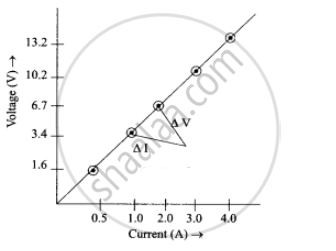Advertisements
Advertisements
प्रश्न
Exercise.
The values of current (I) flowing through a resistor for various potential differences V across the resistor are given below. What is the value of resistor?
| I (ampere) | 0.5 | 1.0 | 2.0 | 3.0 | 4.0 |
| V (volt) | 1.6 | 3.4 | 6.7 | 10.2 | 13.2 |
उत्तर

Resistance(R) = \[\frac{\text{∆V}}{\text{∆I}}\]
= 10.2 – `"6.7"/"3"` – 2 = 3.5/1
R = 3.5Ω
APPEARS IN
संबंधित प्रश्न
Two copper wires are of the same length, but one is thicker than the other. Which wire will have more resistance?
Resistance of a wire depends on, ______.
The effective resistance of three resistors connected in series is lesser than the lowest of the individual resistances.
What happens to the resistance, as the conductor is made thicker?
An electric bulb is rated ‘240 V, 100 W’.
- What information can you get from the above statement?
- What will happen if this bulb is connected across 220 V?
- Calculate the resistance of the bulb.
- Also find the energy consumed by the bulb in 10 minutes.
What is resistance?
The resistance of a straight conductor is independent of ______.
The resistance of a conductor is R. If Its length is doubled, then its new resistance will be ______.
Three resistors are connected in parallel with a battery. If the current in each resistor is 2A, then the current through the battery will be ______.
Two copper wires are of the same length, but one is thicker than the other. Which wire will have more specific resistance?
